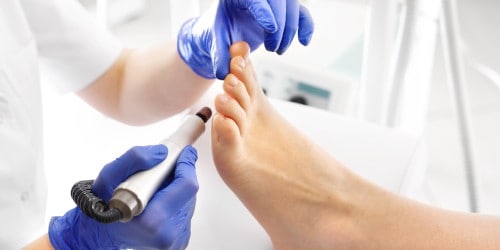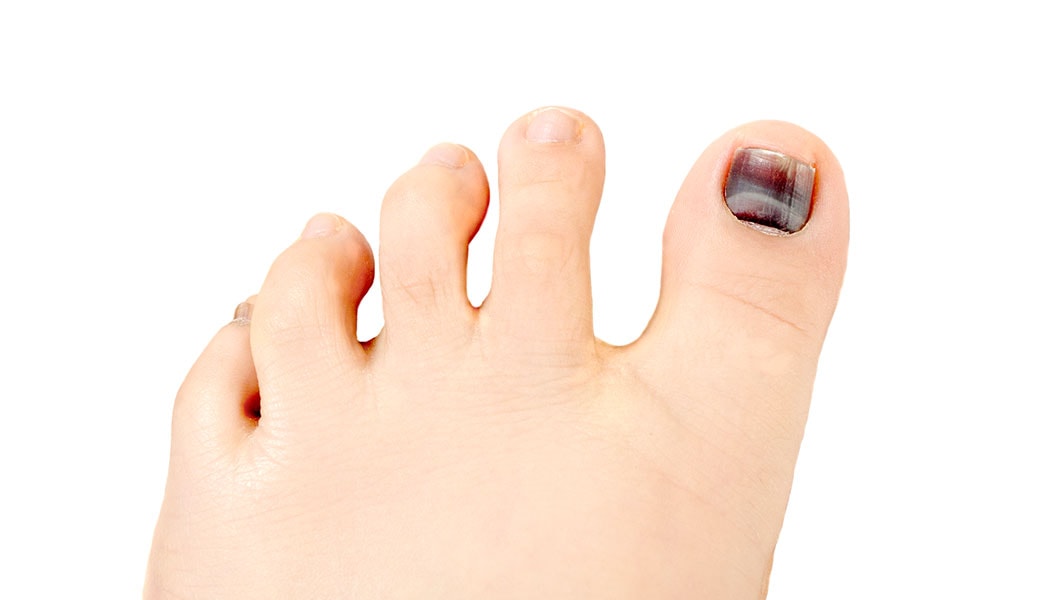- Home
- Foot & Ankle Conditions
- Toenails Conditions
- Onychogryphosis (ram's horn nail)
Onychogryphosis (ram's horn nail)
- Published 10/31/2022
- Last Reviewed 2/24/2025

What is onychogryphosis?
A type of nail dystrophy, onychogryphosis is the rampant growth of the toenails — most often the big toe (great toenail). Also called ram’s horn nails, this condition occurs when one or more toenails grow considerably faster than the others. Onychogryphosis describes the claw-like hypertrophy and thickening of the nail plate.
The afflicted nail frequently exhibits discoloration and hardness. The condition is characterized by an opaque, yellow-brown nail plate with elongation and increased curvature. Sometimes, the nail growth curves back into the skin and causes an ingrown toenail.
- What are the causes of onychogryphosis?
- Who is most at risk of developing onychogryphosis?
- Does toenail fungal infection cause onychogryphosis?
- What is the differential diagnosis for onychogryphosis?
- What is the treatment for onychogryphosis?
- What are surgical treatments for onychogryphosis?
- What is the outcome of onychogryphosis treatment?
- Can you prevent onychogryphosis?
- Why trust UFAI for your onychogryphosis treatment?
-
Dr. Gina Nalbandian specializes in reconstructive and revisional foot and ankle surgery, foot and ankle trauma, sports medicine, lapiplasty, and limb salvage.
While an undergrad, Gina volunteered at free clinics, hospitals and with the AIDS Project in Los Angeles, all the while exploring various careers in medicine. She also conducted and published her research in the lab on campus. “I soon found out that the lab life wasn’t for me, and I wanted a more hands-on approach to medicine,” she says.
Dr. Nalbandian did her residency at St. Elizabeth’s Medical Center in Boston, which is affiliated with Tufts University. As a resident, she served an academic coordinator and chief resident.
A resident of Sherman Oaks, Gina continues to volunteer her expertise with the Special Olympics, Happy Feet (providing foot care at homeless shelters), and the Boston Marathon.
 If you have a foot or ankle issue this is the place to go. I have seen Dr Briskin 3-4 times for ingrown toenail, corn, etc. He ...Laura D.
If you have a foot or ankle issue this is the place to go. I have seen Dr Briskin 3-4 times for ingrown toenail, corn, etc. He ...Laura D. I liked it.Liisa L.
I liked it.Liisa L. I depend on the doctors at UFAI to provide cutting edge treatments. Twice, I have traveled from Tucson, Arizona to get the car...Jean S.
I depend on the doctors at UFAI to provide cutting edge treatments. Twice, I have traveled from Tucson, Arizona to get the car...Jean S. They helped me in an emergency situation. Will go in for consultation with a Dr H????
They helped me in an emergency situation. Will go in for consultation with a Dr H????
Re foot durgeryYvonne S. It went very smoothly.Maria S.
It went very smoothly.Maria S. My experience at the clinic was wonderful. Everybody was super nice and basically on time. Love Dr. Bavarian and also love the ...Lynn B.
My experience at the clinic was wonderful. Everybody was super nice and basically on time. Love Dr. Bavarian and also love the ...Lynn B. I fill I got the best service there is thank youJames G.
I fill I got the best service there is thank youJames G. My experience with your practice far exceeded any of my expectations! The staff was always friendly, positive and informative. ...Christy M.
My experience with your practice far exceeded any of my expectations! The staff was always friendly, positive and informative. ...Christy M. It's been years finally moving forward getting my bunions and hammer toes corrected surgery went well now in the recovery proc...Mark A.
It's been years finally moving forward getting my bunions and hammer toes corrected surgery went well now in the recovery proc...Mark A. Love Dr. Johnson.Emily C.
Love Dr. Johnson.Emily C. I am a new patient and felt very comfortable from the moment I arrived to the end of my visit/appointment.Timothy L.
I am a new patient and felt very comfortable from the moment I arrived to the end of my visit/appointment.Timothy L. Dr. Feldman always listens and takes care of my problem.Joni H.
Dr. Feldman always listens and takes care of my problem.Joni H.
-
 Listen Now
Paronychia: Treating and Avoiding Annoying Nail Infections
Read More
Listen Now
Paronychia: Treating and Avoiding Annoying Nail Infections
Read More
-
 Foot Injuries in Kids: What to look for
Read More
Foot Injuries in Kids: What to look for
Read More
-
 Listen Now
Beat the 6 Most Common Walking Pains
Read More
Listen Now
Beat the 6 Most Common Walking Pains
Read More
-
 Treating Athlete’s Foot with Garlic? Prepare to Be Burned, Literally!
Read More
Treating Athlete’s Foot with Garlic? Prepare to Be Burned, Literally!
Read More
-
 A Podiatrist Tells Us What to Look for (AND AVOID) when Getting a Pedicure
Read More
A Podiatrist Tells Us What to Look for (AND AVOID) when Getting a Pedicure
Read More
-
 Listen Now
Medical Pedicures: What Are They and Do I Need One?
Read More
Listen Now
Medical Pedicures: What Are They and Do I Need One?
Read More
-
 Listen Now
When to See a Doctor for an Ingrown Toenail
Read More
Listen Now
When to See a Doctor for an Ingrown Toenail
Read More
-
 Listen Now
What Causes a Black Toenail? Should You Be Worried?
Read More
Listen Now
What Causes a Black Toenail? Should You Be Worried?
Read More
-
 Listen Now
What To Do When Your Toenail Is Falling Off
Read More
Listen Now
What To Do When Your Toenail Is Falling Off
Read More
-
 Training for a Marathon? 4 ways to avoid foot pain
Read More
Training for a Marathon? 4 ways to avoid foot pain
Read More










